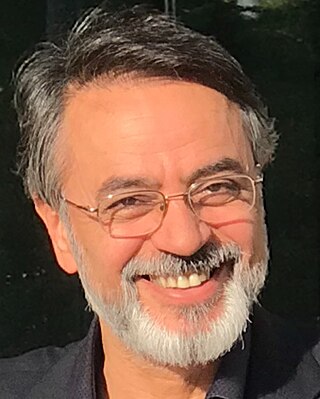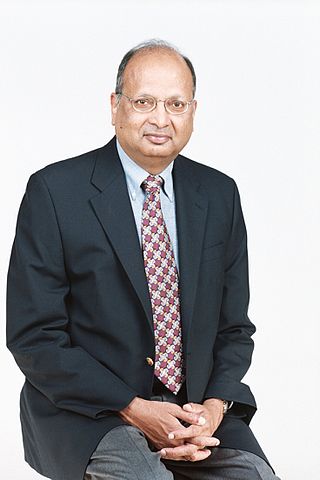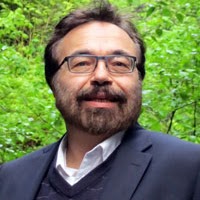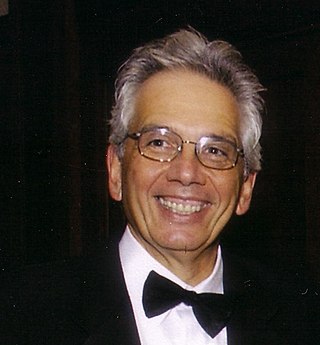
Bell Labs is an American industrial research and scientific development company. Researchers from there are credited with the development of radio astronomy, the transistor, the laser, the photovoltaic cell, the charge-coupled device (CCD), information theory, the Unix operating system, and the programming languages B, C, C++, S, SNOBOL, AWK, AMPL, and others. Ten Nobel Prizes and five Turing Awards have been awarded for work completed at Bell Laboratories.
Space–time block coding is a technique used in wireless communications to transmit multiple copies of a data stream across a number of antennas and to exploit the various received versions of the data to improve the reliability of data transfer. The fact that the transmitted signal must traverse a potentially difficult environment with scattering, reflection, refraction and so on and may then be further corrupted by thermal noise in the receiver means that some of the received copies of the data may be closer to the original signal than others. This redundancy results in a higher chance of being able to use one or more of the received copies to correctly decode the received signal. In fact, space–time coding combines all the copies of the received signal in an optimal way to extract as much information from each of them as possible.

Crawford Hill, sometimes known in the past as Crawford's Hill, is located in Holmdel Township, New Jersey, United States. It is Monmouth County's highest point, as well as the highest point in New Jersey's coastal plain, standing 391 feet (119 m) above sea level. The hill is best known as the site of a Bell Telephone Laboratories facility that was an annex to the Bell Labs Holmdel Complex located three miles away. The 43-acre annex property is comprised of a main research building and a number of other structures and scientific instruments, among them the historic Holmdel Horn Antenna.

Jawad A. Salehi, IEEE Fellow & Optica Fellow, born in Kazemain (Kadhimiya), Iraq, on December 22, 1956, is an Iranian electrical and computer engineer, pioneer of optical code division multiple access (CDMA) and a highly cited researcher. He is also a board member of Academy of Sciences of Iran and a fellow of Islamic World Academy of Sciences. He was also elected as a member of Iranian Science and Culture Hall of Fame in Electrical Engineering, October 2010.

Arogyaswami J. Paulraj is an Indian-American electrical engineer, academic. He is a Professor Emeritus in the Dept. of Elect. Engg. at Stanford University.
Stewart David Personick is an American researcher in telecommunications and computer networking. He worked at Bell Labs, TRW, and Bellcore, researching optical fiber receiver design, propagation in multi-mode optical fibers, time-domain reflectometry, and the end-to-end modeling of fiber-optic communication systems.
Bell Laboratories Layer Space-Time (BLAST) is a transceiver architecture for offering spatial multiplexing over multiple-antenna wireless communication systems. Such systems have multiple antennas at both the transmitter and the receiver in an effort to exploit the many different paths between the two in a highly-scattering wireless environment. BLAST was developed by Gerard Foschini at Lucent Technologies' Bell Laboratories. By careful allocation of the data to be transmitted to the transmitting antennas, multiple data streams can be transmitted simultaneously within a single frequency band — the data capacity of the system then grows directly in line with the number of antennas. This represents a significant advance on current, single-antenna systems.

In radio, multiple-input and multiple-output (MIMO) is a method for multiplying the capacity of a radio link using multiple transmission and receiving antennas to exploit multipath propagation. MIMO has become an essential element of wireless communication standards including IEEE 802.11n, IEEE 802.11ac, HSPA+ (3G), WiMAX, and Long Term Evolution (LTE). More recently, MIMO has been applied to power-line communication for three-wire installations as part of the ITU G.hn standard and of the HomePlug AV2 specification.
The IEEE Eric E. Sumner Award is a Technical Field Award of the IEEE. It was established by the IEEE board of directors in 1995. It may be presented annually, to an individual or a team of not more than three people, for outstanding contributions to communications technology. It is named in honor of Eric E. Sumner, 1991 IEEE President.
Yeheskel Bar-Ness is a Distinguished Professor Emeritus at New Jersey Institute of Technology (NJIT).
Philip Thomas Porter was an electrical engineer and one of the guiding pioneers of the invention and development of early cellular telephone networks.

Georgios B. Giannakis is a Greek-American Computer Scientist, engineer and inventor. He has been an Endowed Chair Professor of Wireless Telecommunications, he was Director of the Digital Technology Center, and at present he is a McKnight Presidential Chair with the Department of Electrical and Computer Engineering at the University of Minnesota.
The first smart antennas were developed for military communications and intelligence gathering. The growth of cellular telephone in the 1980s attracted interest in commercial applications. The upgrade to digital radio technology in the mobile phone, indoor wireless network, and satellite broadcasting industries created new opportunities for smart antennas in the 1990s, culminating in the development of the MIMO technology used in 4G wireless networks.
David Skellern is an Australian electronic engineer and computer scientist credited, along with colleagues, for the first chip-set implementation of the IEEE 802.11a wireless networking standard.

Richard D. Gitlin is an electrical engineer, inventor, research executive, and academic whose principal places of employment were Bell Labs and the University of South Florida (USF). He is known for his work on digital subscriber line (DSL), multi-code CDMA, and smart MIMO antenna technology all while at Bell Labs.
Ranjan Kumar Mallik is an Indian electrical and communications engineer and a professor at the Department of Electrical Engineering of the Indian Institute of Technology, Delhi. He held the Jai Gupta Chair at IIT Delhi from 2007 to 2012 and the Brigadier Bhopinder Singh Chair from 2012 to 2017. He is known for his researches on multiple-input multi-output systems and is an elected fellow of all the three major Indian science academies viz. Indian Academy of Sciences, Indian National Science Academy, and The National Academy of Sciences, India. He is also an elected fellow of The World Academy of Sciences, Indian National Academy of Engineering, and The Institute of Electrical and Electronics Engineers, Inc.
Neelesh B. Mehta is an Indian communications engineer, inventor and a professor at the Department of Electrical and Communications Engineering of the Indian Institute of Science who studies wireless networks.
Nambirajan Seshadri is a professor of practice at the Department of Electrical and Computer Engineering, Jacobs School of Engineering, University of California, San Diego.
Chan-Byoung Chae is a Korean computer scientist, electrical engineer, and academic. He is an Underwood Distinguished Professor and Yonsei Lee Youn Jae Fellow, the director of Intelligence Networking Laboratory, and head of the School of Integrated Technology at Yonsei University, Korea.
Mathini Sellathurai is an electrical engineer whose research topics include wireless communications, radar, cognitive radio, and multiple-input and multiple-output radio communications. Educated in Sri Lanka, Sweden and Canada, she has worked in Canada, the US, and Scotland, where she is professor in signal processing and dean of science and engineering at Heriot-Watt University.







